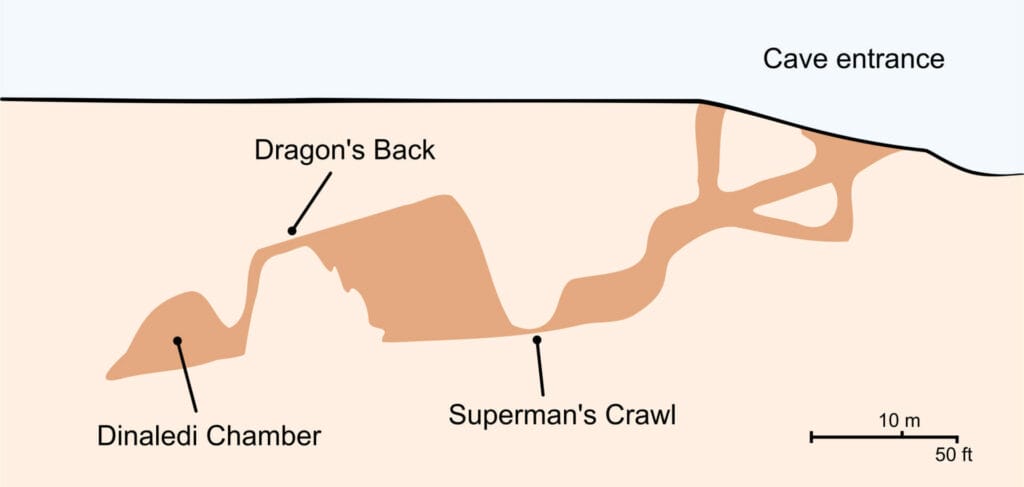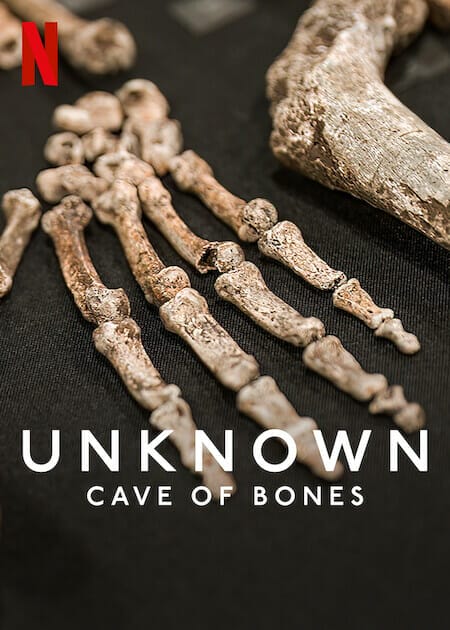‘Unknown: Cave of Bones‘ is a 2023 Netflix documentary that follows paleoanthropologist Lee Berger as he and his team investigate the what might be considered the world’s oldest graveyard to date, and it has turned out not to be human. The site, known as the Rising Star Cave, is located in South Africa’s Cradle of Humankind and contains the remains of over 15 individuals who lived over 250,000 years ago, members of the species Homo naledi.
‘Unknown: Cave of Bones’ is part of the series ‘Unknown’ and this installment is directed by Mark Mannucci.
This documentary tells us how the team led by Lee Berger made a great discovery and managed to reconstruct the skeleton of an entire homo naledi.
A spectacular documentary that, perfect for the initiated and the uninitiated in paleoanthropology, where we follow how the team went about going into an intricate cave system, and the logistics of the endeavor, and where they found fossils of a species that purportedly practiced the first funeral rites. The documentary claims that there was a relationship between this species, which lacked a prehensile thumb and measured one and a half meters, and human beings.
The discovery of a new hominid species?
The documentary explores the possibility that these individuals, who were members of the species Homo naledi, practiced complex burial rituals. This would be a significant discovery, as it would suggest that these early hominids had a more sophisticated understanding of death and the afterlife than previously thought.
The documentary also examines the challenges that Berger and his team faced in excavating the site. The Rising Star Cave is extremely narrow and difficult to access, and the remains of the individuals were found in tight spaces. Berger and his team had to use innovative techniques to recover the bones without damaging them.
Unknown: Cave of Bones is a rather fascinating documentary that offers a glimpse into the lives of our early ancestors. It is a thought-provoking exploration of what it means to be human, and it raises important questions about the origins of belief and religion.
Our Opinion
Unknown: Cave of Bones is a well-made and thought-provoking documentary that offers a novel perspective of a species past. We recommend it to anyone interested in anthropology, archaeology, or the history of religion. We did miss the opinions and observations of other experts in the field. It is nevertheless entertaining.

Rising Star cave
The Rising Star cave, located in the Cradle of Humankind World Heritage Site in South Africa, is a karstic cave system situated in the Malmani dolomites near the Bloubank River valley. It covers an area of 250 × 150 m and consists of mapped passageways within a gently west dipping open fold. The cave is stratigraphically bound to a stromatolitic dolomite horizon in the lower parts of the Monte Christo Formation, which contains several thin chert marker horizons used to determine the position of chambers within the system. Read more
Homo naledi
Homo naledi, a hominin species, inhabited South Africa from approximately 236,000 to 335,000 years ago. In 2013, a group of South African and American scientists, led by Lee Berger, uncovered the fossils in the Rising Star Cave, situated within the Cradle of Humankind World Heritage Site. Read more
Lee Burger

Lee Rogers Berger is a known paleoanthropologist that has dedicated part of his career to making major fossil discoveries. His best known finds include Australopithecus sediba, an ancient human relative discovered in 2008 in South Africa, and Homo naledi, a fossil hominin species announced in 2015. Berger’s discoveries are notable not just for their scientific value but also for his efforts to make them open access projects, freely sharing data and fossils with researchers. In addition to his research, Berger has received numerous awards for his work including the first National Geographic Society Prize for Research and Exploration in 1997. Berger has lived and worked in South Africa since 1989 where he continues to research human origins at the University of the Witwatersrand. Read more
